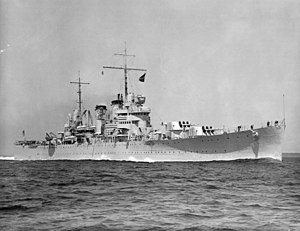Amphibious Battle of Gela
| Battle of Gela (1943) | |||||||
|---|---|---|---|---|---|---|---|
| Part of the Allied invasion of Sicily in the Mediterranean theatre of World War II | |||||||
 Brooklyn-class cruisers Boise, (pictured) and her sister ship Savannah, demonstrated the effectiveness of naval gunfire against tanks. |
|||||||
|
|||||||
| Belligerents | |||||||
|
|
|
||||||
| Commanders and leaders | |||||||
|
|
|
||||||
| Strength | |||||||
|
1st Infantry Division (United States) 2nd Armored Division (United States) USS Savannah USS Boise HMS Abercrombie USS Shubrick USS Jeffers USS Maddox (DD-622) USS Butler USS Glennon |
Italian XVIII Coastal Brigade 4 Mountain Infantry Division Livorno Fallschirm-Panzer Division 1 Hermann Göring Luftflotte 2 |
||||||
| Casualties and losses | |||||||
|
U.S.: 2,300-3,000 casualties, Maddox sunk |
Italian: 3,300 killed 5,000 wounded 2,000 prisoners German: 630 killed, wounded, and prisoners 14 tanks |
||||||
The amphibious Battle of Gela was the opening engagement of the United States portion of the Allied Invasion of Sicily. United States Navy ships landed United States Army troops along the eastern end of the south coast of Sicily; and withstood attacks by Luftwaffe and Regia Aeronautica aircraft while defending the beachhead against German and Italian tanks until the Army captured the Ponte Olivo Airfield for use by United States Army Air Forces planes. The battle convinced United States Army officers of the value of naval artillery support, and revealed problems coordinating air support from autonomous air forces during amphibious operations.
The invasion of Sicily followed the Allied capture of Tunisia in north Africa and preceded the Allied invasion of Italy as a means of diverting Axis forces from the eastern front with the Soviet Union until the Western Allies were prepared to invade occupied Europe through France. Ground forces under overall command of General Dwight D. Eisenhower were transported by naval forces under overall command of Admiral Andrew Cunningham. The invasion was constrained by marginally effective air cover from 670 Allied fighters operating at maximum range which limited patrolling time over one hundred miles of invasion beaches and prevented proportional response to incoming raids. There were three wings (twenty squadrons) of Supermarine Spitfires operating from airfields on Malta and two groups of Curtiss P-40 Warhawks from airfields on Pantelleria and Gozo. Allied air forces refused to provide air support for Allied ground forces until Axis air forces had been neutralized; and, since Axis bombing continued through 12 July, the role of Allied aircraft was negligible in the fighting at Gela. Pre-invasion strategic bombing reduced Luftflotte 2 strength to 175 planes in Sicily, but 418 additional Luftwaffe and 449 Regia Aeronautica aircraft remained serviceable at bases in Italy to be flown in as required.
...
Wikipedia
